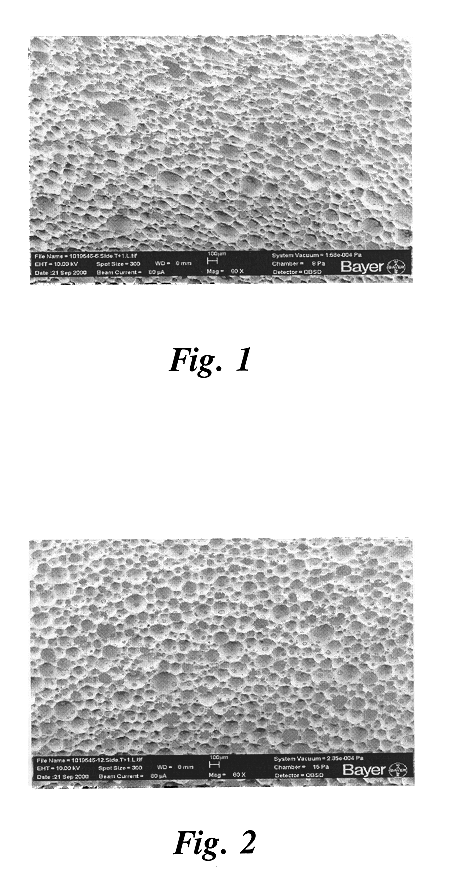Carbon dioxide blown low density, flexible microcellular elastomers suitable for preparing shoe components
a microcellular elastomer and low density technology, applied in the field of carbon dioxide blown low density, flexible microcellular elastomers suitable for preparing shoe components, can solve the problems of exceptionally difficult production of water-blown microcellular foam, and achieve the effects of low density, low density and high hardness
- Summary
- Abstract
- Description
- Claims
- Application Information
AI Technical Summary
Benefits of technology
Problems solved by technology
Method used
Image
Examples
example 1
In the above formulation 1.0 g / l of CO.sub.2 was dissolved in the prepolymer side and 0.1 g / l CO.sub.2 was dissolved in the polyol side. The tanks were maintained at 50 psi and 35 degrees .degree. C. This resulted in foam densities of the separate components at atmospheric pressure of 0.52 and 0.95 glcm.sup.3 respectively. The two components were mixed at a ratio of 0.84 using a low pressure machine and the material allowed to flow and expand into a 10 mm thick mold.
example 2
In the above formulation 1.4 g / l of CO.sub.2 was dissolved in the prepolymer side and 0.95 g / l CO.sub.2 was dissolved in the polyol side. The tanks were maintained at 50 psi and 35 degrees .degree. C. This resulted in individual foam densities at atmospheric pressure of 0.31 and 0.51 g / cm.sup.3 respectively. The two components were mixed at a ratio of 0.84 using a low pressure machine and the material allowed to flow and expand into a 10 mm thick mold.
example 3
In the above formulation 1.5 g / l of CO.sub.2 was dissolved in the prepolymer side and 1.25 g / l CO.sub.2 was dissolved in the polyol side. The tanks were maintained at 50 psi and 35 degrees .degree. C. This resulted in foam densities at atmospheric pressure of 0.25 and 0.37 g / cm.sup.3 respectively. The two components were mixed at a ratio of 0.84 using a low pressure machine and the material allowed to flow and expand into a 10 mm thick mold.
The properties obtained from these examples are compared in the following table:
As can be seen, the subject invention process produces elastomers with high hardness values. Even at an ultra-low density of about 0.23 g / cm.sup.3, the hardness is still 36 on the Asker C scale, and the resilience quite high as well, nearly as high as a part with three times the density. Such physical properties have not previously been obtained at such low density.
PUM
| Property | Measurement | Unit |
|---|---|---|
| density | aaaaa | aaaaa |
| molecular weight | aaaaa | aaaaa |
| diameter | aaaaa | aaaaa |
Abstract
Description
Claims
Application Information
 Login to View More
Login to View More - R&D
- Intellectual Property
- Life Sciences
- Materials
- Tech Scout
- Unparalleled Data Quality
- Higher Quality Content
- 60% Fewer Hallucinations
Browse by: Latest US Patents, China's latest patents, Technical Efficacy Thesaurus, Application Domain, Technology Topic, Popular Technical Reports.
© 2025 PatSnap. All rights reserved.Legal|Privacy policy|Modern Slavery Act Transparency Statement|Sitemap|About US| Contact US: help@patsnap.com

